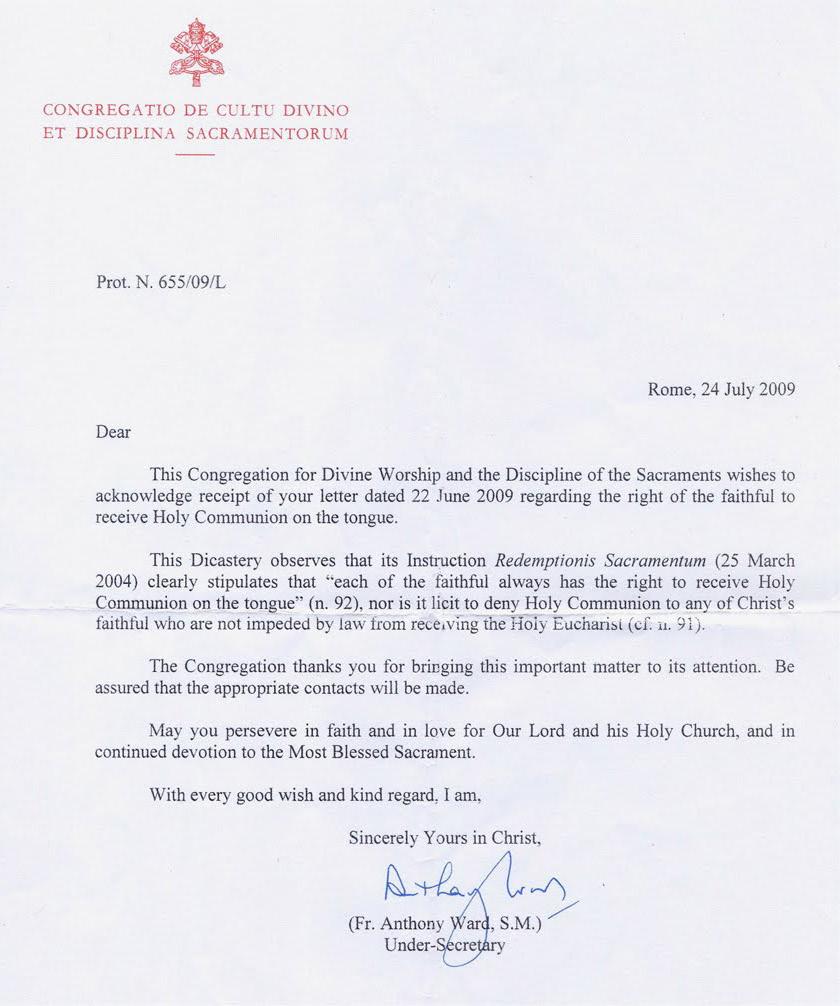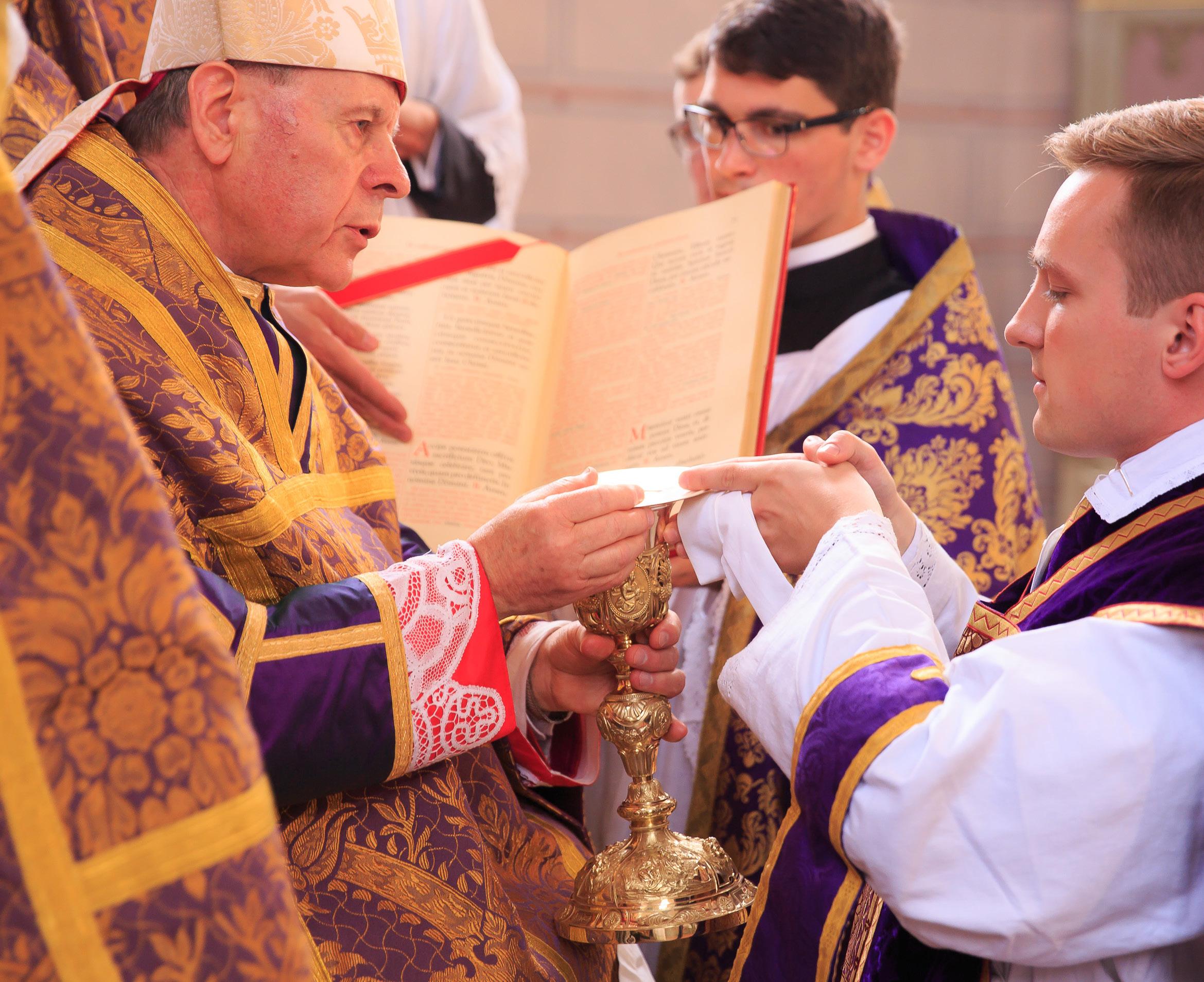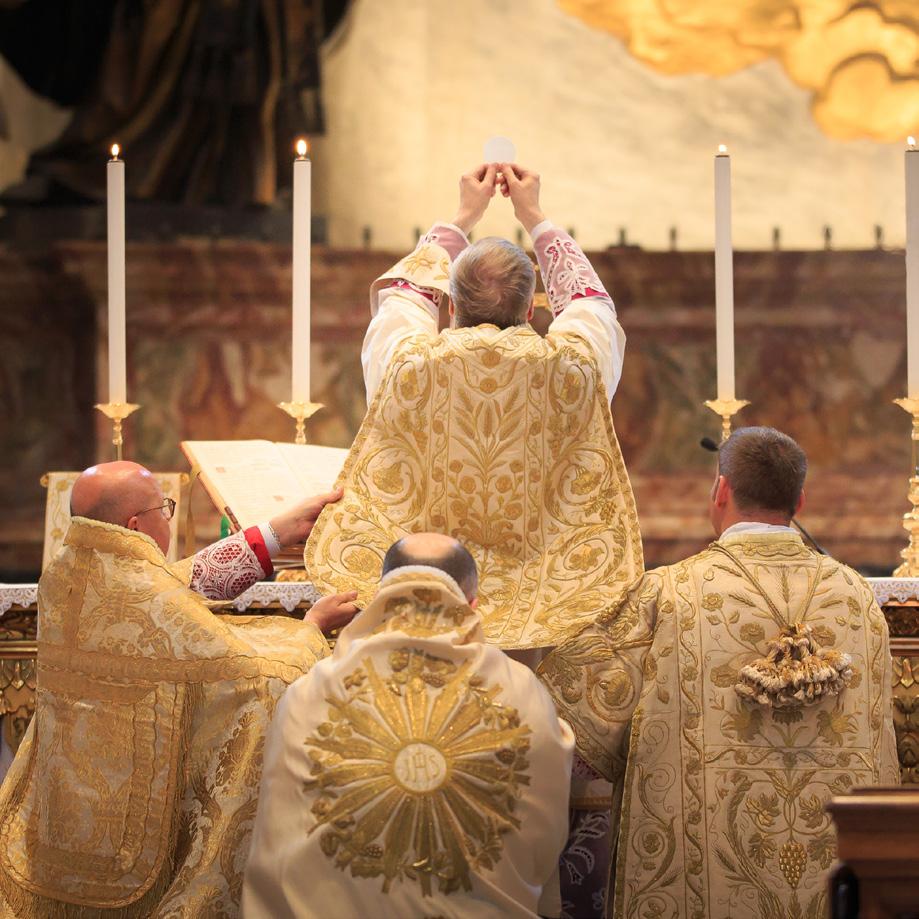
13 minute read
Five reasons for receiving Holy Communion on the tongue
by JOHN-HENRY WESTEN
With orders to refuse the faithful Holy Communion on the tongue coming from governmental health authorities and even some bishops, I would like to share with you a few of the reasons that have convinced me never to receive Holy Communion on the hand. And, if the matter was forced, I would make the sacrifice of making a spiritual Holy Communion.
Advertisement
1. Reverence due to Almighty God Receiving on the tongue comes from a deep reverential love of the King of Kings whom we receive in the Sacrament of the Holy Eucharist. Some of the most powerful arguments for the need for this type of reverence are in the Bible.
TRANSFIGURAITON (C.1500). PIETRO VANNUCCI. COLLEGIO DEL CAMBIO, PERUGIA. PUBLIC DOMAIN
When God spoke to Moses from the burning bush, as we read in Exodus 3, He told him not to come too near and to remove his sandals because he was on holy ground. In Psalm 95 we read, “Come let us adore and fall down: and weep before the Lord that made us.” We see it in the New Testament too, when Peter, James, and John at the Transfiguration on Mount Tabor, saw the glorified body of Jesus, which we receive in Holy Communion – they prostrated themselves with their foreheads to the ground.
However, the Biblical account that speaks to this subject most directly for me is what happened with the Ark of the Covenant (2 Samuel 6:1-7 and 1 Chronicles 13:9-12). The Ark of the Covenant was designed by God and built to the Lord’s specifications. It contained manna, the staff of Moses, and the tablets of the Ten Commandments. It was so sacred that it was never allowed to be touched except by certain Levites – the priests of the time. That reservation of touching the Ark to priests only was potently reinforced when a layman named Uzzah who was transporting the Ark at the request of King David was struck dead by God for touching it.
Uzzah was doing what he thought was right to save the Ark. He and his brother were transporting the Ark in a cart pulled by oxen. Along the journey, it was tilted and so Uzzah used his hand to steady the Ark and was struck dead by the Lord. Scripture explains that the Lord struck him down because he was not to touch the Ark.
It is very much the same in our time when many are trying to do what they think is right during the coronavirus by receiving Communion on the hand.
And yet with the Ark, it was not the right thing to do even though it is what seemed expedient – it was done for good intentions to save the Ark from harm, just as many are receiving Holy Communion on the hand today with good intent to safeguard their brothers and sisters in Christ from possible coronavirus

infection or to help the Church, so she may continue to distribute Holy Communion at all.
Nevertheless, touching the Ark was the wrong thing to do. The Lord’s decision here perplexed David, who thereafter was afraid to bring the Ark of the Lord to himself.
And yet what was the Ark of the Covenant compared to Our Lord Himself in the Eucharist? The Ark was revered in the temple. It was carried in ceremony and was considered holy. And yet it was only the footstool of God. It was His presence, veiled, and a prefiguring of His Real Presence in the Person of Our Lord Jesus Christ, whom we receive in Holy Communion.
2. The authority of the Church While we are dealing with the coronavirus pandemic, it is important to know that the Church has already considered the matter of the allowance of Holy Communion on the tongue while facing the spread of this type of virus even in modern times. In 2009, during the H1N1 influenza pandemic, a lay Catholic in England in a diocese where Holy Communion on the tongue was restricted due to the pandemic wrote to the Vatican about the matter.
The response from the Congregation for Divine Worship and Discipline of the Sacraments, dated 14 July 2009, was posted online by Rorate Caeli blog. The Congregation, which is tasked with authoritatively responding to such questions, wrote back quoting Church law on the subject as laid out in the instruction Redemptionis Sacramentum, saying, “each of the faithful always has the right to receive Holy Communion on the tongue” (n. 92), “nor is it licit to deny Holy Communion to any of Christ’s faithful who are not impeded by law from receiving the Holy Eucharist” (cf. n. 91).1
The Vatican response added, “The Congregation thanks you for bringing this important matter to its attention. Be assured that the appropriate contacts will be made.”
Canonist Cathy Caridi pointed out the significance of that line at the Canon Law Made Easy blog. Caridi says, it “makes clear that after sending this letter, the CDW intended to contact the clergy who were illegally barring Catholics from receiving Communion on the tongue, to inform them in a formal, official way that by doing so that they were violating the law.”2

Caridi concludes:
“It would be only logical to assume that if the faithful contact the CDW now, with information about current illegal practices in their own parishes/dioceses where they are forbidden to receive Communion on the tongue; the CDW will respond in precisely the same way.
“The CDW will have to respond in the same way, not because coronavirus isn’t dangerous, but because the right of the faithful around the world to receive the Eucharist in the way that is the Church’s established norm – on the tongue – cannot be curtailed by anyone other than the Supreme Authority of the Church. This is an issue not of germs, but of the Church’s hierarchical structure. No bishop on earth (still less a parish priest acting on his own!) has the authority to countermand a law or specific directive of the Vatican that is intended to apply to the universal Church.”3
3. The witness of angels, saints and popes St. Thomas Aquinas wrote in his Summa Theologiae:
“Out of reverence towards this Sacrament, nothing touches it but what is consecrated, hence the corporal and the chalice are consecrated, and likewise the priest’s hands, for touching this sacrament.
PHOTO CREDIT: DON ELVIR TABAKOVIĆ, CAN. REG.

Hence it is not lawful for anyone else to touch it, except from necessity, for instance, if it were to fall upon the ground, or else in some other case of urgency.” (16 ST, III, Q. 82, Art. 13)
In 2008, Pope Benedict decided to stop giving Holy Communion on the hand and would only give Holy Communion to the faithful on the tongue and kneeling. A Vatican web-page commemorating this decision was published in 2009 (updated to include a photo of Pope Francis) and can still be found on the Vatican website. The page says:
“From the time of the Fathers of the Church, a tendency was born and consolidated whereby distribution of Holy Communion in the hand became more and more restricted in favour of distributing Holy Communion on the tongue. The motivation for this practice is two-fold: a) first, to avoid, as much as possible, the dropping of Eucharistic particles; b) second, to increase among the faithful devotion to the Real Presence of Christ in the Sacrament of the Eucharist.”4
The webpage concludes: “...starting with the Solemnity of Corpus Christi in the year 2008, the Holy Father, Benedict XVI, began to distribute to the faithful the Body of the Lord, by placing it directly on the tongue of the faithful as they remain kneeling.”
A celebrated saying of St. Augustine, cited by Pope Benedict XVI in n. 66 of his Apostolic exhortation Sacramentum Caritatis, teaches: “No one eats that flesh without first adoring it; we should sin were we not to adore it” (Enarrationes in Psalmos 98, 9). Kneeling indicates the adoration necessary before receiving the Eucharistic Christ.
At one of the appearances of the Angel of Peace to the children in Fatima, the Angel brought Holy Communion to them. The Angel prostrated himself before the Eucharistic Lord, teaching the children to do the same.
4. Profanation or desecration of the Holy Eucharist In 2014, when he was asked to address the chief concern with Communion on the hand, namely the loss of fragments of the Eucharistic Christ, Bishop Athanasius Schneider told the magazine of the Latin Mass Society of England and Wales:
“To my knowledge and experience, the deepest wound in the actual crisis of the Church is the Eucharistic wound; the abuses of the Blessed Sacrament…
“There is…the question of the objectively irreverent reception of Holy Communion. The so-called new, modern manner of receiving Holy Communion directly into the hand is very serious because it exposes Christ to an enormous banality.
“There is the grievous fact of the loss of the Eucharistic fragments. No one can deny this. And the fragments of the consecrated host are crushed by feet. This is horrible! Our God, in our churches, is trampled by feet! No one can deny it.
“And this is happening on a large scale. This has to be, for a person with faith and love for God, a very serious phenomenon.
“We cannot continue as if Jesus as God does not exist, as though only the bread exists. This modern practice of Communion in the hand has nothing to do with the practice in the ancient Church. The modern practice of receiving Communion in hand contributes gradually to the loss of the Catholic faith in the real presence and in the transubstantiation.
“A priest and a bishop cannot say this practice is ok. Here is at stake the most holy, the most divine and concrete on Earth.” 5. Communion on the hand was re-introduced by way of abuse, deceit, and betrayal From an in-depth and heavily referenced study of the question by Michael Davies we learn:
“Communion in the hand was re-introduced into the Catholic Church as an act of rebellion soon after Vatican II. It began in Holland as an arbitrary act of defiance of legitimate authority (...) and the practice spread to Germany, Belgium, and France.
“The consequences of this rebellion became so serious that the Pope consulted the Bishops of the world, and, after obtaining their opinions, promulgated the Instruction Memoriale Domini, in 1969. This Instruction is included and will be referred to from time to time. The principal points contained in it are: 1. The Bishops of the world were overwhelmingly against the innovation. 2. The traditional manner of distributing Holy Communion must be retained. 3. It is a sign of reverence which does not detract from the dignity of the communicant. 4. The innovation could lead to irreverence, profanation, and the adulteration of correct doctrine.
“Therefore: The Apostolic See strongly urges bishops, priests, people to observe this law, valid and again confirmed, according to the judgment of the majority of the Catholic episcopate, in the form which the present rite of the sacred liturgy employs, and out of concern for the common good of the Church.”5
Davies says, however, a calamitous error of judgment then followed. It was agreed that wherever the practice “has already developed in any place” a two-thirds majority of the episcopal conference could petition the Holy See for permission to legalise the abuse. Quite clearly, the phrase “has already developed” meant by that date, 28 May 1969. Countries where the practice had not developed by that date were obviously excluded from the concession – and all the English-speaking countries come into this category.
When the US Conference of Catholic Bishops debated the question in 1977, Bishop Blanchette pointed out that the procedure approved by the Vatican was that permission could be requested from the Holy See if the contrary usage prevailed. He pointed out that
the bishops could hardly take the second step without taking the first.
Bishop Blanchette is reported in the National Catholic Register of 12 June 1977 recollecting,
“I said, we are now going to discuss and probably vote on whether we want to petition the Holy See, and we have not established that a contrary usage prevails. I said a simple way to do that would be to ask the Ordinaries to indicate whether in their dioceses the contrary usage prevails. The Ordinary should know, he is the shepherd of the diocese. He has been asked to obey and his priests have been asked to obey, so if anybody knows whether the contrary usage prevails, he should. And so I asked that the agenda be amended so that the first step – finding out whether the contrary usage prevails – could be verified, and if it were verified then we could get on with the rest of the agenda. But if the first step is not verified, how can we logically go on to the second step? That was my motion.”
Michael Davies explains:
“Bishop Blanchette’s motion was supported in writing by five other bishops and sustained by the president of the conference. According to the rules, there should have been a written vote, but supporters of the innovation objected and voted, on a show of hands, to rule the president out of order. It therefore seems quite reasonable to ask: just how legal was this vote? Then, of course, other extraordinary measures were taken to get the innovation adopted. Retired bishops were prevented from voting, and, when the necessary majority had still not been achieved, bishops who had not been present were polled until the necessary total was arrived at.”
So as you can see, Communion on the hand in modern times came by way of abuse, deceit, and betrayal.
It is for these reasons that I believe Catholics should not receive Holy Communion on the hand.
Should you be in a situation where you are refused Holy Communion unless you take it on the hand, I would make a spiritual Communion and then contact the proper authority to remedy the situation. Take that letter that was written by the Vatican on the question

PHOTO CREDIT: DON ELVIR TABAKOVIĆ, CAN. REG.
during the swine flu pandemic in 2009 to your priest or bishop. Ask them to give you Holy Communion at least after Mass if they feel they cannot do it during Mass. And if they still don’t permit you to receive Our Lord on the tongue, apply to the Vatican’s Congregation for Divine Worship with the proof of the denial of Holy Communion on the tongue and pray to God the remedy comes soon.
In the meantime, offer up the sacrifice of being deprived of the Holy Eucharist and attend Mass offering your own pain along with Christ’s Sacrifice.
John-Henry Westen the co-founder and editor-in-chief of LifeSiteNews. He is also the co-founder of Voice of the Family. He and his wife Dianne and their eight children live in the Ottawa Valley in Ontario, Canada. He has spoken at conferences and retreats, and appeared on radio and television throughout North America, Europe and Asia. He is a consultant to Canada’s largest pro-life organisation Campaign Life Coalition and the host of the John-Henry Westen Show.
ENDNOTES:
1. Rorate Caeli, “It is not licit to deny communion on the tongue due to H1N1”, 26 November 2009, https://rorate-caeli.blogspot.com/2009/11/it-is-not-licit-todeny-communion-on.html 2. Cathy Caridi, “Can we be required to receive Communion in the hand, because of the virus?, Canon Law Made Easy, 12 March 2020, https://canonlawmadeeasy. com/2020/03/12/communion-in-the-hand-virus/ 3. Ibid. 4. Office for the Liturgical Celebrations of the Supreme Pontiff, “Communion received on the tongue and while kneeling”, http://www.vatican.va/news_services/liturgy/ details/ns_lit_doc_20091117_comunione_en.html 5. Michael Davies, “Communion in the hand and similar frauds”, https://sspx.org/sites/ sspx/files/communion-in-the-hand-and-other-similiar-frauds-michael-davies.pdf










